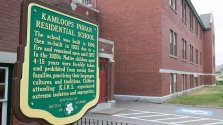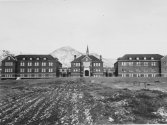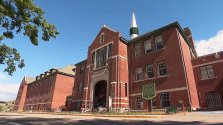Same game play all over the Anglo world...kidnapping, enslavement, abuse, genocide
Introduction
By
January 30, 2001
LONDON — In the United States, Native American children, “Red Indians,” had been forcibly taken from their parents and placed in institutions to “civilize” them. Australia tried a different approach.
In 1937, the chief protector of Aboriginals in Western Australia, A. O. Neville, a man generally recognized as a decent, progressive bureaucrat but who nevertheless believed in “breeding out the color” (commonly called “[expletive deleted] them white”), spoke at the first national governmental conference on Aboriginals, an occasion Robert Marine, associate professor of politics at La Trobe University, Victoria, has described as “a terrible moment in the history of the 20th-century Australian state.”
At the conference, Neville asked: “Are we going to have a population of one million blacks in the Commonwealth or are we going to merge them into our white community and eventually forget that there were any Aborigines in Australia?” The key resolution at the conference, “The Destiny of the Race,” passed unanimously, called for the total absorption into the white community of all non-full-blood Aborigines. Taking part-Aboriginal children from their mothers and families by force was part of this ambition. Over the years, various regulations had been invoked to make this possible.
Illegal: White man with Aboriginal woman
In 1918, while the war in Europe was still on, the Australian government found time to pass regulations designed to segregate Aboriginals from the white population and reduce the number of children with mixed blood. It was now illegal for a white man to live with an Aboriginal woman. (No mention was made of a white woman living with an Aboriginal man because such a situation was considered unthinkable.) This met the approval of the
Perth Sunday Times: “Central Australia’s half-caste problem must be tackled boldly and immediately. The greatest danger, experts agree, is that three races will develop in Australia — white, black, and the pathetic, sinister third race which is neither.” Control of all Aboriginal children was removed from their parents and given to government-appointed white superintendents. This was just another part of a process that lasted from the late 19th century until the middle 1960s. So-called “half-caste” children were seized by the state and placed in institutions where they suffered physical mistreatment and sexual abuse. To this day, no one is certain how many were involved — but Aboriginal authorities say at least 30,000.
The 1918 law caused no outcry. Government figures released in 1921 suggested that there were only 75,000 Aboriginals left, the lowest figure ever, and that since colonization, their ranks had been reduced by nearly 80 per cent. There is doubt that these figures were accurate. In the 1970s, a period of strong Aboriginal activism, many Aboriginal leaders I spoke with said that they had done their own, admittedly limited, census-taking in their own areas, and that their figures for the number of Aboriginals suggested that the official figures had been understated by anything from 25 to 50 per cent.
But the low official figures enabled the authorities to argue that since Aboriginals were dying out anyway, the new legislation was aimed at easing their passing and finding decent homes for their children, especially those who had some white blood or light-colored skin.
Kidnapping becomes government policy
This cannot be over-emphasized: The Australian government literally kidnapped these children from their parents as a matter of policy. White welfare officers, often supported by police, would descend on Aboriginal camps, round up all the children, separate the ones with light-colored skin, bundle them into trucks and take them away. If their parents protested, they were held at bay by the police.
Sometimes, to avoid harrowing scenes of parents clinging to the sides of the trucks, and to frustrate attempts to hide the children when the trucks drove into the camp, the authorities resorted to subterfuge. They would fit out the back of a truck with a wire cage and a spring door — like an animal trap. Then they would park the truck a short distance from the camp and lure the children into the cage with sweets scattered on its door. When enough children were in the cage, they would spring the trap door and drive rapidly away.
Aboriginals tried to save their children by blackening their skin so that they did not look half-caste. “Every morning, our people would crush charcoal and mix that with animal fat and smother it all over us, so that when the police came they could see only black children in the distance,” witness No. 681 told the National Inquiry into “stolen children” (1995-97). “We were told to be on the alert and, if white people came, to run into the bush, or stand behind the trees as stiff as a poker, or else run behind logs or run into culverts and hide.
Mothers were equally stricken. “Bringing Them Home,” the 1997 report of the Human Rights and Equal Opportunity Commission into stolen children, tells of an Aboriginal woman so ashamed of being unable to prevent her children being taken from her that she carried on her person, until the day she died, references testifying to her good character. And of an Aboriginal family who for 32 years carried out a ritual mourning ceremony every sunrise and sunset to mark the loss of their daughter.
Siblings separated — easier to control
Where the children were taken depended on how old and how light-skinned they were. (Either way, siblings would not be allowed to stay together because the authorities believed that what they called the “split the litter” system made the children easier to control.) Some started out in Roman Catholic orphanages where they were well treated — “All the kids thought it was one big family. We didn’t know what it meant by ‘parents’ because we didn’t have parents and we thought those women [the nuns] were our mothers,” one said.
But as they grew older, they were moved on to “homes” run by churches and missionary societies. There, they were beaten and sometimes sexually abused. Some of the stolen children did not have even a short spell of reasonable life, but went straight from the Aboriginal camp from which they had been abducted into so-called “half-caste homes” in Darwin or Alice Springs. The aim was to keep them segregated from local “full bloods.” Conditions in these homes were deplorable. At Alice Springs, the half-caste home, “The Bungalow,” consisted of a very rough frame of wood with some dilapidated sheets of corrugated iron thrown over it.
The prime minister, Stanley Bruce, thought something should be done about the half-caste homes and made an approach to the South Australian government to try to persuade it to help. He suggested: “If these babies were removed at their present early age . . . to homes in South Australia, they would not know in later life that they had Aboriginal blood and would probably be absorbed into the white population and become useful citizens.” The South Australian government was having none of this. It replied: “To give effect to this suggestion would be greatly to the disadvantage of South Australia . . . These persons of Aboriginal blood almost invariably mate with the lowest class of whites and, in many cases, the girls become prostitutes.”
Robert Manne found in the National Archives of Australia the views of Dr. Cecil Cook, who had the job of “chief protector of Aborigines” in the Northern Territory between 1927 and 1939 and the architect of Aboriginal policy there. Manne wrote in the
Sydney Morning Herald in 1999, “No one endowed the sorry business of child removal with a grander social and geopolitical purpose than . . . the progressive intellectual, Dr. Cecil Cook.”





